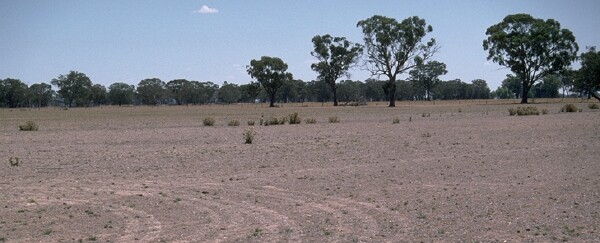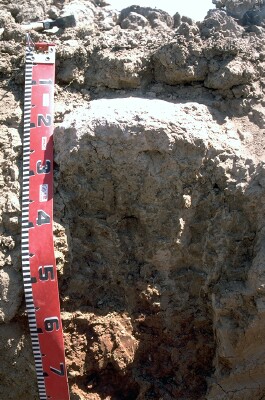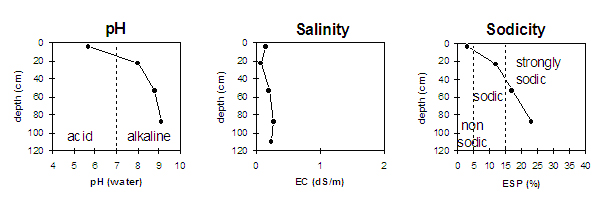LP33
| Group: Bridgewater Farm Advance | Australian Soil Classification: Ferric (and Hypocalcic), Subnatric, Brown SODOSOL |
| Northcote Factual Key:Dy 2.43 | Great Soil Group: solodized solonetz |
| General Landscape Description: Level alluvial plain. The original vegetation consisted of Grey Box (Eucalyptus microcarpa). | |
 LP33 Landscape |
Soil Profile Morphology
Surface Soil
| A1 | 0-7 cm | Dark yellowish brown (10YR3/4); fine sandy loam, hardsetting surface condition; massive; strong consistence dry; pH 5.7; sharp and smooth change to: |  LP33 Profile |
| A2 | 7-10 cm | Brown (10YR4/3) conspicuously bleached (10YR7/1d); fine sandy clay loam; massive; strong consistence dry; abrupt and wavy change to: | |
| Subsoil | |||
| B21 | 10-35 cm | Yellowish brown (10YR5/6); light medium clay; moderate very coarse columnar structure; very strong consistence dry; pH 8.0: | |
| B22 | 35-70 cm | Yellowish red (5YR5/6); medium heavy clay; moderate coarse angular blocky structure (with shiny faced peds); very strong consistence dry; pH 8.8: | |
| B23 | 70-105 cm | Dark yellowish brown (10YR4/4) with 25% yellowish red (5YR5/6); medium clay; weakly structured; strong consistence dry; contains many (20-50%) ferromanganiferous nodules with very few (<2%) carbonate (with silica) nodules and a few (2-10%) fine quartz; pH 9.1: | |
| B24 | 105+ cm | Yellowish red (5YR5/6); light clay; weakly structured; very strong consistence dry; contains very few (<2%) carbonate (with silica) nodules. | |
Key Profile Features
- Strong texture contrast between the surface (A) horizons and the clay (B) subsoil.
- Hardsetting nature of the soil surface.
- Conspicuously bleached A2 horizon.
- Coarse columnar structure at the top of the subsoil.
Key Profile Characteristics
pH | Salinity Rating | |||
Surface (A1 horizon) | moderately acid | very low | non-sodic | none1 |
Subsoil (B21 horizon) | moderately alkaline | very low | sodic | complete |
Deeper subsoil (at 1 m) | very strongly alkaline | low | strongly sodic | __ |
| 1Strong dispersion after remoulding. | ||||
 |
Management Considerations:
Surface (A) Horizons
- The surface soil has a low-moderate overall nutrient status. Organic carbon and total nitrogen levels are reasonable. Improving organic matter levels will assist in minimising structural problems such as surface sealing and hardsetting, as well as improving soil fertility and water holding capacity.
- When dry the surface soil becomes hard and may be difficult to work. The soil disperses strongly when remoulded which indicates that excessive cultivation or over-stocking when the soil is wet may lead to surface crusting and exacerbate the hardsetting condition. A cultivated soil is also likely to suffer structural damage from raindrop action. A cover of plants or stubble will provide some protection.
Subsoil (B) Horizons
- The dense and coarsely structured subsoil is sodic and disperses completely in water. This will result in soil structural conditions which limit water and plant root movement through the profile. The presence of a conspicuously bleached A2 horizon indicates that water movement into the subsoil is restricted and that periodic waterlogging occurs.
Landholder comments:
- Paddock under pasture for the past 2-3 years, prior to this oats wheat and barley were successfully cropped.
- Gypsum has been added in a neighbouring paddock. The soil has responded well and is easier to plough.
Notes
- Profile described by Mark Imhof, Paul Rampant and Sonia Thompson (14/2/95).


